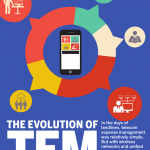Through this blog series, we’ve looked at the “Wild West” nature of mobility billing and various ways for businesses of all size to wrangle their out-of-control costs. We reviewed ways to manage the monthly cost of mobility, as well as the importance of performing routine maintenance on your master agreement to ensure your contracted features align with your company’s needs.
The mobility needs for business users are continually evolving. Technology is developed and released rapidly by manufacturers who are in a never-ending race to be the first and the best. This evolution of technology has several potential impacts to businesses of all sizes:
- Employees are fast to adopt new technology in their personal lives. Apple reportedly sold 9 million iPhone 5S & C models in the first three days after launch. Employees, especially the younger generation that grew up with Google, expect tools at work that allow them to communicate and collaborate easily. Keeping up with technology increases job performance and satisfaction.
- Evolution of smartphones, specifically, means an evolution of apps: they’re getting bigger and better, which requires more and more data. While the knee-jerk reaction is to restrict data usage (block YouTube and Netflix), there are legitimate applications that will improve communication: video conferencing from the tablet, cloud-based CRM (customer relationship management) software that allows your mobile sales team to update and share in real-time, and much more.
What’s the bottom line? Keeping your mobility fleet outfitted with current hardware and job-appropriate apps will increase employee performance and satisfaction. The question is: how does a business maintain current technology without breaking the bank? Keep your contract current!
Contract re-negotiating should include a hardware refresh at a minimum. For larger businesses, negotiate customized contract terms that will minimize potential service charges over the life of the contract. For one of our clients, we negotiated 1 free early upgrade “token” per user that can be redeemed for any user in the fleet. What does that mean? This customer has 500 devices, giving them 500 free early upgrades that can be used at any time, for any user. Let’s be honest: there’s always a few employees that are prone to breaking their phone a couple times a year – replacing their devices can quickly add up! Having these transferable “tokens” means that we can, in theory, upgrade 1 user’s phone every week if we had to, without paying an early upgrade service charge (up to $400 per upgrade).
This is just another example of what an experienced, “in-the-know”, independent consultant can negotiate for your company. The big 3 (“RoBellUS”) capitalize on businesses that don’t know to ask for customized features and terms in their contract. They profit from businesses that don’t understand, or don’t have the time to solve, the puzzle that exists within every month’s bill.
Rogers recently released the 2013 earnings of the executive team. The 6 Rogers executives’ earnings totaled close to $49 million. Most shocking is that new CEO Guy Laurence earned $12.7 million in 2013, having started his employment on December 2nd. (Note: this isn’t intended to “pick on” Rogers; all 3 of the big providers structure their executive salaries and incentives similarly)
Stop overpaying on mobility services! Mobility providers are profiting from businesses that are not proactively managing their contracts and bills. Call us today at 519-963-3035 or email jcaley@nielsenitconsulting.com for a no-risk review.
Jennifer Caley,
Telecommunication Expense Management (TEM), Wireless Telecommunication Expense Management (WTEM) and Service Desk Manager
Mobility Cost-Saving Case Study
Over this blog series, Nielsen IT’s mobility service expert Jennifer Caley will explore the importance of a monthly billing review, routinely scheduled contract renegotiation, and tips for regularly renewing your hardware fleet with current technology at minimal cost to the business.
- Part 1: Introduction
- Part 2: Managing Monthly Costs
- Part 3: Keeping Mobility Contracts Current
- Part 4: Outfit Staff with Current Technology at No Additional Cost




